Avondale NURS20029 Essay: Pneumonia, Family Impact, Nursing Activities
VerifiedAdded on 2022/10/10
|11
|3061
|492
Essay
AI Summary
This essay explores the complexities of pneumonia in a child and its profound impact on the family. It details the causes, diagnosis, and treatment of pneumonia, highlighting the challenges faced by the family during the child's illness and recovery. The essay emphasizes the importance of holis...

RUNNING HEAD: NURSING 0
NURSING
ESSAY WRITING
8/7/2019
NURSING
ESSAY WRITING
8/7/2019
Paraphrase This Document
Need a fresh take? Get an instant paraphrase of this document with our AI Paraphraser
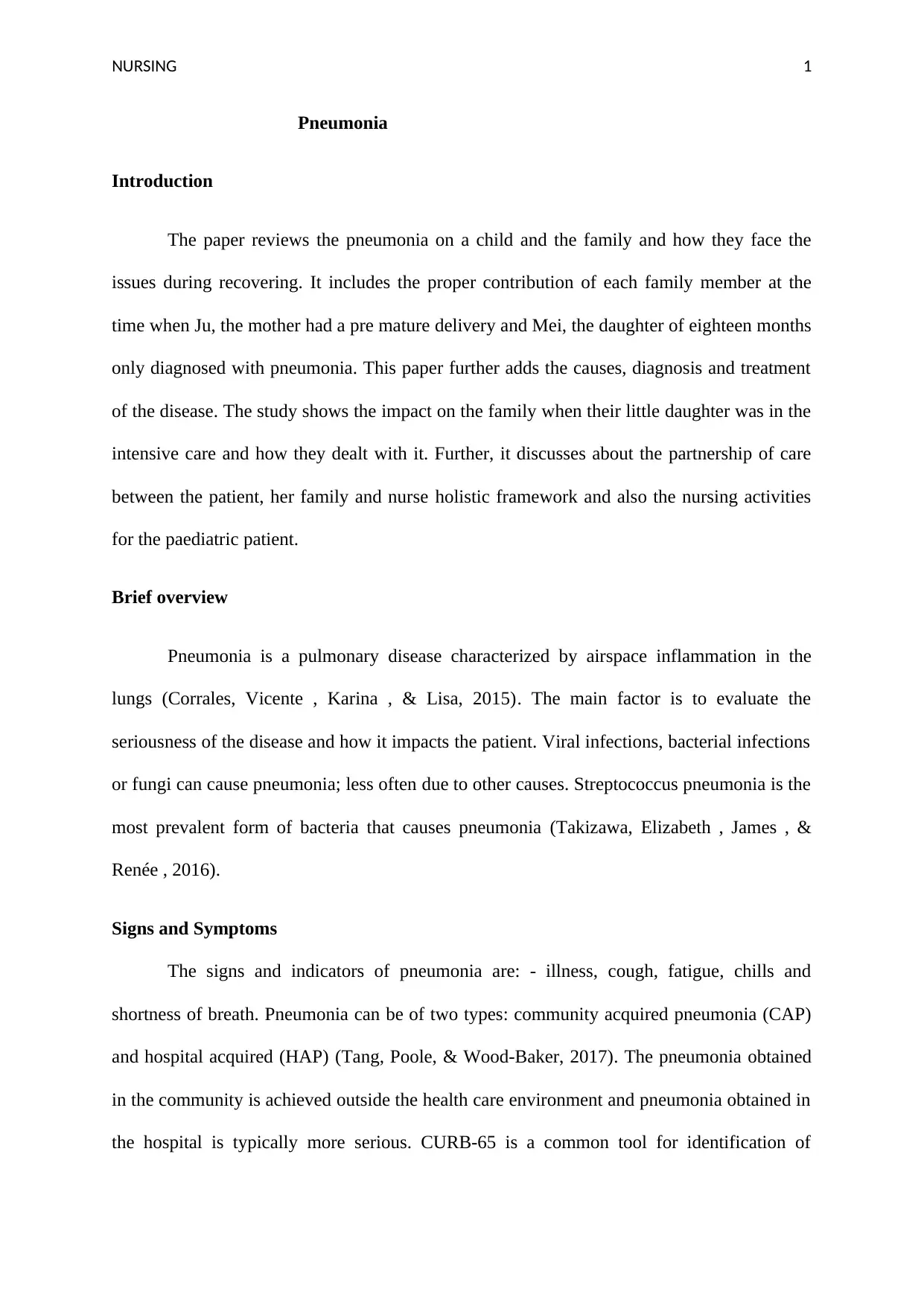
NURSING 1
Pneumonia
Introduction
The paper reviews the pneumonia on a child and the family and how they face the
issues during recovering. It includes the proper contribution of each family member at the
time when Ju, the mother had a pre mature delivery and Mei, the daughter of eighteen months
only diagnosed with pneumonia. This paper further adds the causes, diagnosis and treatment
of the disease. The study shows the impact on the family when their little daughter was in the
intensive care and how they dealt with it. Further, it discusses about the partnership of care
between the patient, her family and nurse holistic framework and also the nursing activities
for the paediatric patient.
Brief overview
Pneumonia is a pulmonary disease characterized by airspace inflammation in the
lungs (Corrales, Vicente , Karina , & Lisa, 2015). The main factor is to evaluate the
seriousness of the disease and how it impacts the patient. Viral infections, bacterial infections
or fungi can cause pneumonia; less often due to other causes. Streptococcus pneumonia is the
most prevalent form of bacteria that causes pneumonia (Takizawa, Elizabeth , James , &
Renée , 2016).
Signs and Symptoms
The signs and indicators of pneumonia are: - illness, cough, fatigue, chills and
shortness of breath. Pneumonia can be of two types: community acquired pneumonia (CAP)
and hospital acquired (HAP) (Tang, Poole, & Wood‐Baker, 2017). The pneumonia obtained
in the community is achieved outside the health care environment and pneumonia obtained in
the hospital is typically more serious. CURB-65 is a common tool for identification of
Pneumonia
Introduction
The paper reviews the pneumonia on a child and the family and how they face the
issues during recovering. It includes the proper contribution of each family member at the
time when Ju, the mother had a pre mature delivery and Mei, the daughter of eighteen months
only diagnosed with pneumonia. This paper further adds the causes, diagnosis and treatment
of the disease. The study shows the impact on the family when their little daughter was in the
intensive care and how they dealt with it. Further, it discusses about the partnership of care
between the patient, her family and nurse holistic framework and also the nursing activities
for the paediatric patient.
Brief overview
Pneumonia is a pulmonary disease characterized by airspace inflammation in the
lungs (Corrales, Vicente , Karina , & Lisa, 2015). The main factor is to evaluate the
seriousness of the disease and how it impacts the patient. Viral infections, bacterial infections
or fungi can cause pneumonia; less often due to other causes. Streptococcus pneumonia is the
most prevalent form of bacteria that causes pneumonia (Takizawa, Elizabeth , James , &
Renée , 2016).
Signs and Symptoms
The signs and indicators of pneumonia are: - illness, cough, fatigue, chills and
shortness of breath. Pneumonia can be of two types: community acquired pneumonia (CAP)
and hospital acquired (HAP) (Tang, Poole, & Wood‐Baker, 2017). The pneumonia obtained
in the community is achieved outside the health care environment and pneumonia obtained in
the hospital is typically more serious. CURB-65 is a common tool for identification of
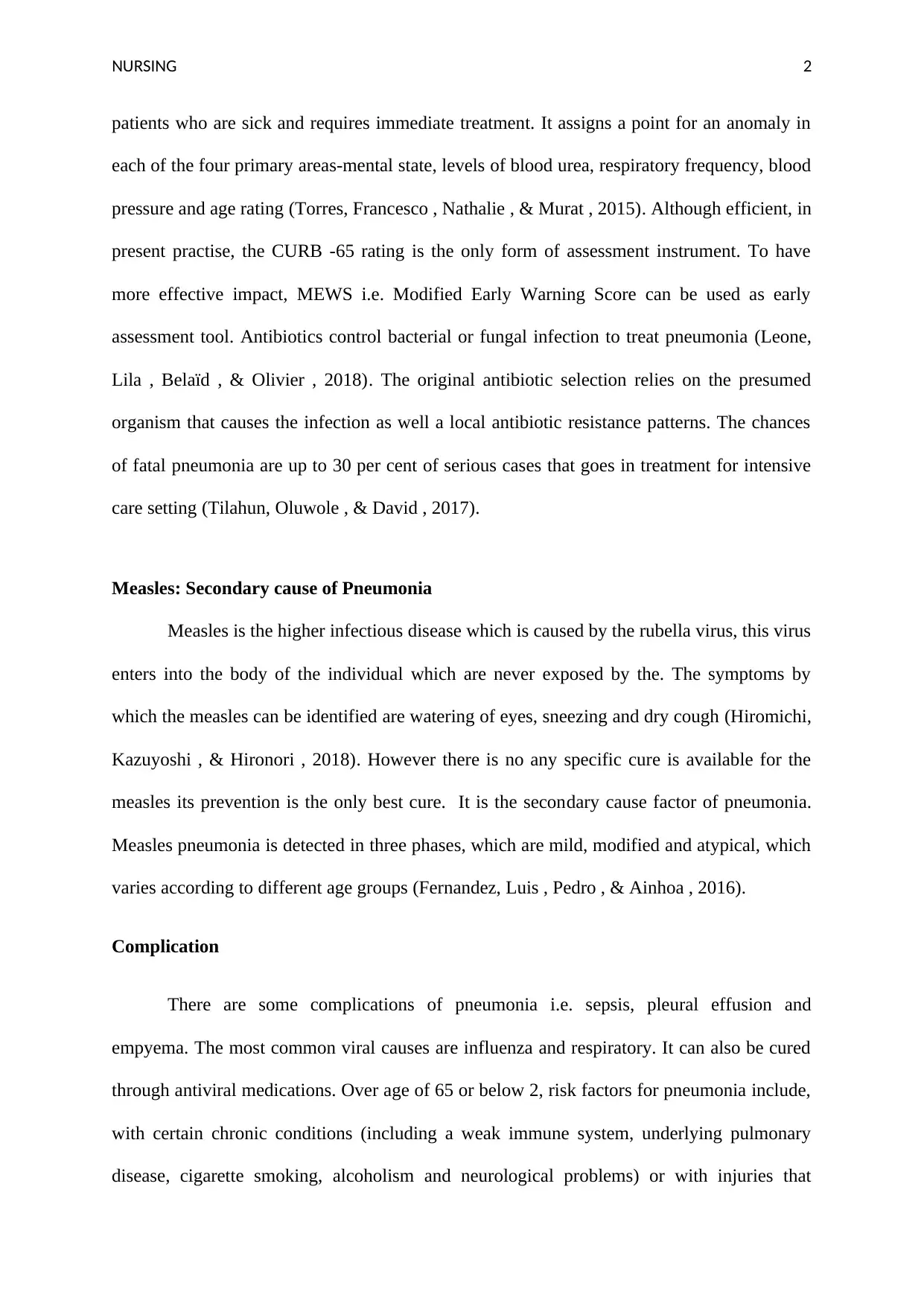
NURSING 2
patients who are sick and requires immediate treatment. It assigns a point for an anomaly in
each of the four primary areas-mental state, levels of blood urea, respiratory frequency, blood
pressure and age rating (Torres, Francesco , Nathalie , & Murat , 2015). Although efficient, in
present practise, the CURB -65 rating is the only form of assessment instrument. To have
more effective impact, MEWS i.e. Modified Early Warning Score can be used as early
assessment tool. Antibiotics control bacterial or fungal infection to treat pneumonia (Leone,
Lila , Belaïd , & Olivier , 2018). The original antibiotic selection relies on the presumed
organism that causes the infection as well a local antibiotic resistance patterns. The chances
of fatal pneumonia are up to 30 per cent of serious cases that goes in treatment for intensive
care setting (Tilahun, Oluwole , & David , 2017).
Measles: Secondary cause of Pneumonia
Measles is the higher infectious disease which is caused by the rubella virus, this virus
enters into the body of the individual which are never exposed by the. The symptoms by
which the measles can be identified are watering of eyes, sneezing and dry cough (Hiromichi,
Kazuyoshi , & Hironori , 2018). However there is no any specific cure is available for the
measles its prevention is the only best cure. It is the secondary cause factor of pneumonia.
Measles pneumonia is detected in three phases, which are mild, modified and atypical, which
varies according to different age groups (Fernandez, Luis , Pedro , & Ainhoa , 2016).
Complication
There are some complications of pneumonia i.e. sepsis, pleural effusion and
empyema. The most common viral causes are influenza and respiratory. It can also be cured
through antiviral medications. Over age of 65 or below 2, risk factors for pneumonia include,
with certain chronic conditions (including a weak immune system, underlying pulmonary
disease, cigarette smoking, alcoholism and neurological problems) or with injuries that
patients who are sick and requires immediate treatment. It assigns a point for an anomaly in
each of the four primary areas-mental state, levels of blood urea, respiratory frequency, blood
pressure and age rating (Torres, Francesco , Nathalie , & Murat , 2015). Although efficient, in
present practise, the CURB -65 rating is the only form of assessment instrument. To have
more effective impact, MEWS i.e. Modified Early Warning Score can be used as early
assessment tool. Antibiotics control bacterial or fungal infection to treat pneumonia (Leone,
Lila , Belaïd , & Olivier , 2018). The original antibiotic selection relies on the presumed
organism that causes the infection as well a local antibiotic resistance patterns. The chances
of fatal pneumonia are up to 30 per cent of serious cases that goes in treatment for intensive
care setting (Tilahun, Oluwole , & David , 2017).
Measles: Secondary cause of Pneumonia
Measles is the higher infectious disease which is caused by the rubella virus, this virus
enters into the body of the individual which are never exposed by the. The symptoms by
which the measles can be identified are watering of eyes, sneezing and dry cough (Hiromichi,
Kazuyoshi , & Hironori , 2018). However there is no any specific cure is available for the
measles its prevention is the only best cure. It is the secondary cause factor of pneumonia.
Measles pneumonia is detected in three phases, which are mild, modified and atypical, which
varies according to different age groups (Fernandez, Luis , Pedro , & Ainhoa , 2016).
Complication
There are some complications of pneumonia i.e. sepsis, pleural effusion and
empyema. The most common viral causes are influenza and respiratory. It can also be cured
through antiviral medications. Over age of 65 or below 2, risk factors for pneumonia include,
with certain chronic conditions (including a weak immune system, underlying pulmonary
disease, cigarette smoking, alcoholism and neurological problems) or with injuries that
⊘ This is a preview!⊘
Do you want full access?
Subscribe today to unlock all pages.

Trusted by 1+ million students worldwide
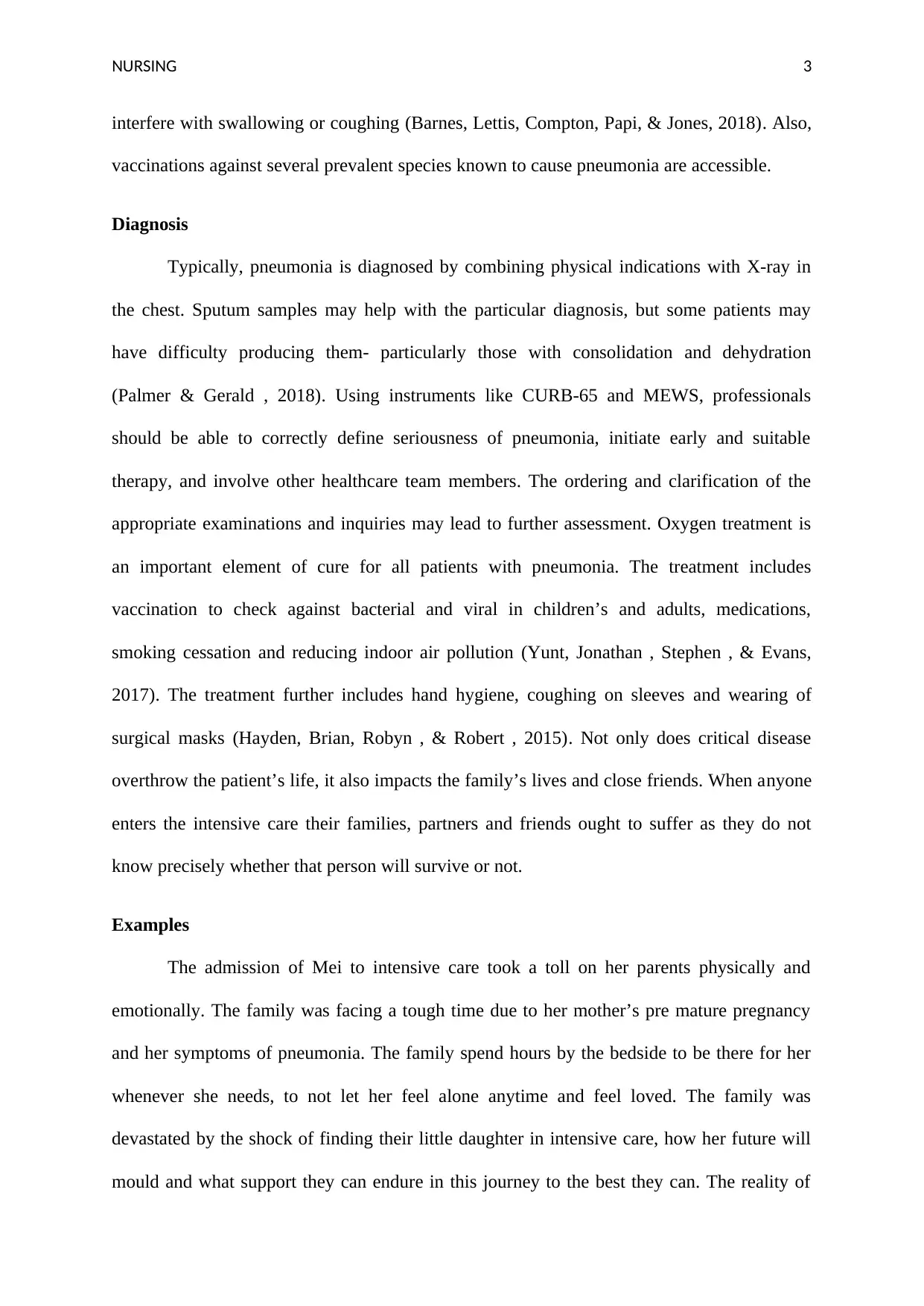
NURSING 3
interfere with swallowing or coughing (Barnes, Lettis, Compton, Papi, & Jones, 2018). Also,
vaccinations against several prevalent species known to cause pneumonia are accessible.
Diagnosis
Typically, pneumonia is diagnosed by combining physical indications with X-ray in
the chest. Sputum samples may help with the particular diagnosis, but some patients may
have difficulty producing them- particularly those with consolidation and dehydration
(Palmer & Gerald , 2018). Using instruments like CURB-65 and MEWS, professionals
should be able to correctly define seriousness of pneumonia, initiate early and suitable
therapy, and involve other healthcare team members. The ordering and clarification of the
appropriate examinations and inquiries may lead to further assessment. Oxygen treatment is
an important element of cure for all patients with pneumonia. The treatment includes
vaccination to check against bacterial and viral in children’s and adults, medications,
smoking cessation and reducing indoor air pollution (Yunt, Jonathan , Stephen , & Evans,
2017). The treatment further includes hand hygiene, coughing on sleeves and wearing of
surgical masks (Hayden, Brian, Robyn , & Robert , 2015). Not only does critical disease
overthrow the patient’s life, it also impacts the family’s lives and close friends. When anyone
enters the intensive care their families, partners and friends ought to suffer as they do not
know precisely whether that person will survive or not.
Examples
The admission of Mei to intensive care took a toll on her parents physically and
emotionally. The family was facing a tough time due to her mother’s pre mature pregnancy
and her symptoms of pneumonia. The family spend hours by the bedside to be there for her
whenever she needs, to not let her feel alone anytime and feel loved. The family was
devastated by the shock of finding their little daughter in intensive care, how her future will
mould and what support they can endure in this journey to the best they can. The reality of
interfere with swallowing or coughing (Barnes, Lettis, Compton, Papi, & Jones, 2018). Also,
vaccinations against several prevalent species known to cause pneumonia are accessible.
Diagnosis
Typically, pneumonia is diagnosed by combining physical indications with X-ray in
the chest. Sputum samples may help with the particular diagnosis, but some patients may
have difficulty producing them- particularly those with consolidation and dehydration
(Palmer & Gerald , 2018). Using instruments like CURB-65 and MEWS, professionals
should be able to correctly define seriousness of pneumonia, initiate early and suitable
therapy, and involve other healthcare team members. The ordering and clarification of the
appropriate examinations and inquiries may lead to further assessment. Oxygen treatment is
an important element of cure for all patients with pneumonia. The treatment includes
vaccination to check against bacterial and viral in children’s and adults, medications,
smoking cessation and reducing indoor air pollution (Yunt, Jonathan , Stephen , & Evans,
2017). The treatment further includes hand hygiene, coughing on sleeves and wearing of
surgical masks (Hayden, Brian, Robyn , & Robert , 2015). Not only does critical disease
overthrow the patient’s life, it also impacts the family’s lives and close friends. When anyone
enters the intensive care their families, partners and friends ought to suffer as they do not
know precisely whether that person will survive or not.
Examples
The admission of Mei to intensive care took a toll on her parents physically and
emotionally. The family was facing a tough time due to her mother’s pre mature pregnancy
and her symptoms of pneumonia. The family spend hours by the bedside to be there for her
whenever she needs, to not let her feel alone anytime and feel loved. The family was
devastated by the shock of finding their little daughter in intensive care, how her future will
mould and what support they can endure in this journey to the best they can. The reality of
Paraphrase This Document
Need a fresh take? Get an instant paraphrase of this document with our AI Paraphraser
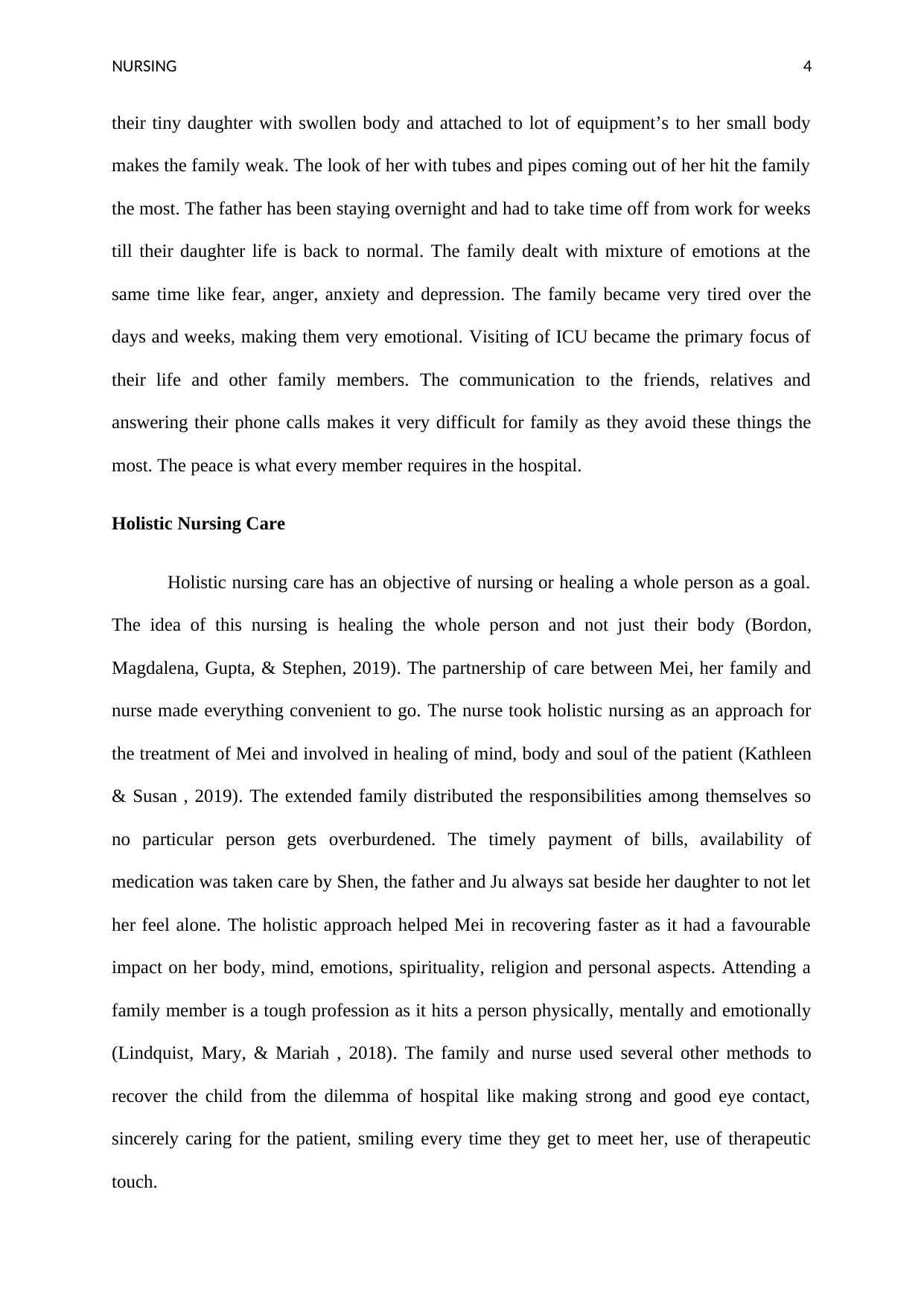
NURSING 4
their tiny daughter with swollen body and attached to lot of equipment’s to her small body
makes the family weak. The look of her with tubes and pipes coming out of her hit the family
the most. The father has been staying overnight and had to take time off from work for weeks
till their daughter life is back to normal. The family dealt with mixture of emotions at the
same time like fear, anger, anxiety and depression. The family became very tired over the
days and weeks, making them very emotional. Visiting of ICU became the primary focus of
their life and other family members. The communication to the friends, relatives and
answering their phone calls makes it very difficult for family as they avoid these things the
most. The peace is what every member requires in the hospital.
Holistic Nursing Care
Holistic nursing care has an objective of nursing or healing a whole person as a goal.
The idea of this nursing is healing the whole person and not just their body (Bordon,
Magdalena, Gupta, & Stephen, 2019). The partnership of care between Mei, her family and
nurse made everything convenient to go. The nurse took holistic nursing as an approach for
the treatment of Mei and involved in healing of mind, body and soul of the patient (Kathleen
& Susan , 2019). The extended family distributed the responsibilities among themselves so
no particular person gets overburdened. The timely payment of bills, availability of
medication was taken care by Shen, the father and Ju always sat beside her daughter to not let
her feel alone. The holistic approach helped Mei in recovering faster as it had a favourable
impact on her body, mind, emotions, spirituality, religion and personal aspects. Attending a
family member is a tough profession as it hits a person physically, mentally and emotionally
(Lindquist, Mary, & Mariah , 2018). The family and nurse used several other methods to
recover the child from the dilemma of hospital like making strong and good eye contact,
sincerely caring for the patient, smiling every time they get to meet her, use of therapeutic
touch.
their tiny daughter with swollen body and attached to lot of equipment’s to her small body
makes the family weak. The look of her with tubes and pipes coming out of her hit the family
the most. The father has been staying overnight and had to take time off from work for weeks
till their daughter life is back to normal. The family dealt with mixture of emotions at the
same time like fear, anger, anxiety and depression. The family became very tired over the
days and weeks, making them very emotional. Visiting of ICU became the primary focus of
their life and other family members. The communication to the friends, relatives and
answering their phone calls makes it very difficult for family as they avoid these things the
most. The peace is what every member requires in the hospital.
Holistic Nursing Care
Holistic nursing care has an objective of nursing or healing a whole person as a goal.
The idea of this nursing is healing the whole person and not just their body (Bordon,
Magdalena, Gupta, & Stephen, 2019). The partnership of care between Mei, her family and
nurse made everything convenient to go. The nurse took holistic nursing as an approach for
the treatment of Mei and involved in healing of mind, body and soul of the patient (Kathleen
& Susan , 2019). The extended family distributed the responsibilities among themselves so
no particular person gets overburdened. The timely payment of bills, availability of
medication was taken care by Shen, the father and Ju always sat beside her daughter to not let
her feel alone. The holistic approach helped Mei in recovering faster as it had a favourable
impact on her body, mind, emotions, spirituality, religion and personal aspects. Attending a
family member is a tough profession as it hits a person physically, mentally and emotionally
(Lindquist, Mary, & Mariah , 2018). The family and nurse used several other methods to
recover the child from the dilemma of hospital like making strong and good eye contact,
sincerely caring for the patient, smiling every time they get to meet her, use of therapeutic
touch.
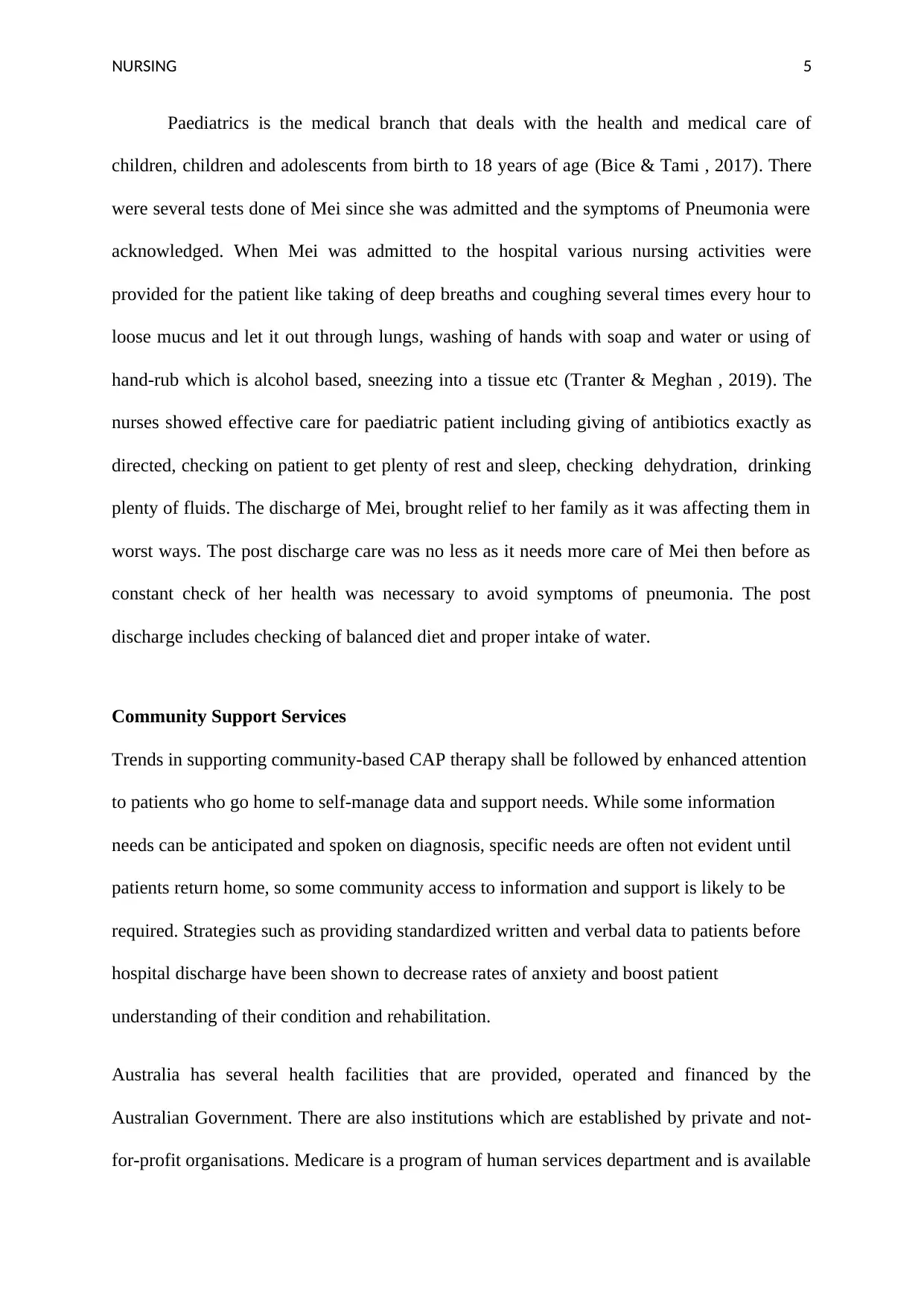
NURSING 5
Paediatrics is the medical branch that deals with the health and medical care of
children, children and adolescents from birth to 18 years of age (Bice & Tami , 2017). There
were several tests done of Mei since she was admitted and the symptoms of Pneumonia were
acknowledged. When Mei was admitted to the hospital various nursing activities were
provided for the patient like taking of deep breaths and coughing several times every hour to
loose mucus and let it out through lungs, washing of hands with soap and water or using of
hand-rub which is alcohol based, sneezing into a tissue etc (Tranter & Meghan , 2019). The
nurses showed effective care for paediatric patient including giving of antibiotics exactly as
directed, checking on patient to get plenty of rest and sleep, checking dehydration, drinking
plenty of fluids. The discharge of Mei, brought relief to her family as it was affecting them in
worst ways. The post discharge care was no less as it needs more care of Mei then before as
constant check of her health was necessary to avoid symptoms of pneumonia. The post
discharge includes checking of balanced diet and proper intake of water.
Community Support Services
Trends in supporting community-based CAP therapy shall be followed by enhanced attention
to patients who go home to self-manage data and support needs. While some information
needs can be anticipated and spoken on diagnosis, specific needs are often not evident until
patients return home, so some community access to information and support is likely to be
required. Strategies such as providing standardized written and verbal data to patients before
hospital discharge have been shown to decrease rates of anxiety and boost patient
understanding of their condition and rehabilitation.
Australia has several health facilities that are provided, operated and financed by the
Australian Government. There are also institutions which are established by private and not-
for-profit organisations. Medicare is a program of human services department and is available
Paediatrics is the medical branch that deals with the health and medical care of
children, children and adolescents from birth to 18 years of age (Bice & Tami , 2017). There
were several tests done of Mei since she was admitted and the symptoms of Pneumonia were
acknowledged. When Mei was admitted to the hospital various nursing activities were
provided for the patient like taking of deep breaths and coughing several times every hour to
loose mucus and let it out through lungs, washing of hands with soap and water or using of
hand-rub which is alcohol based, sneezing into a tissue etc (Tranter & Meghan , 2019). The
nurses showed effective care for paediatric patient including giving of antibiotics exactly as
directed, checking on patient to get plenty of rest and sleep, checking dehydration, drinking
plenty of fluids. The discharge of Mei, brought relief to her family as it was affecting them in
worst ways. The post discharge care was no less as it needs more care of Mei then before as
constant check of her health was necessary to avoid symptoms of pneumonia. The post
discharge includes checking of balanced diet and proper intake of water.
Community Support Services
Trends in supporting community-based CAP therapy shall be followed by enhanced attention
to patients who go home to self-manage data and support needs. While some information
needs can be anticipated and spoken on diagnosis, specific needs are often not evident until
patients return home, so some community access to information and support is likely to be
required. Strategies such as providing standardized written and verbal data to patients before
hospital discharge have been shown to decrease rates of anxiety and boost patient
understanding of their condition and rehabilitation.
Australia has several health facilities that are provided, operated and financed by the
Australian Government. There are also institutions which are established by private and not-
for-profit organisations. Medicare is a program of human services department and is available
⊘ This is a preview!⊘
Do you want full access?
Subscribe today to unlock all pages.

Trusted by 1+ million students worldwide
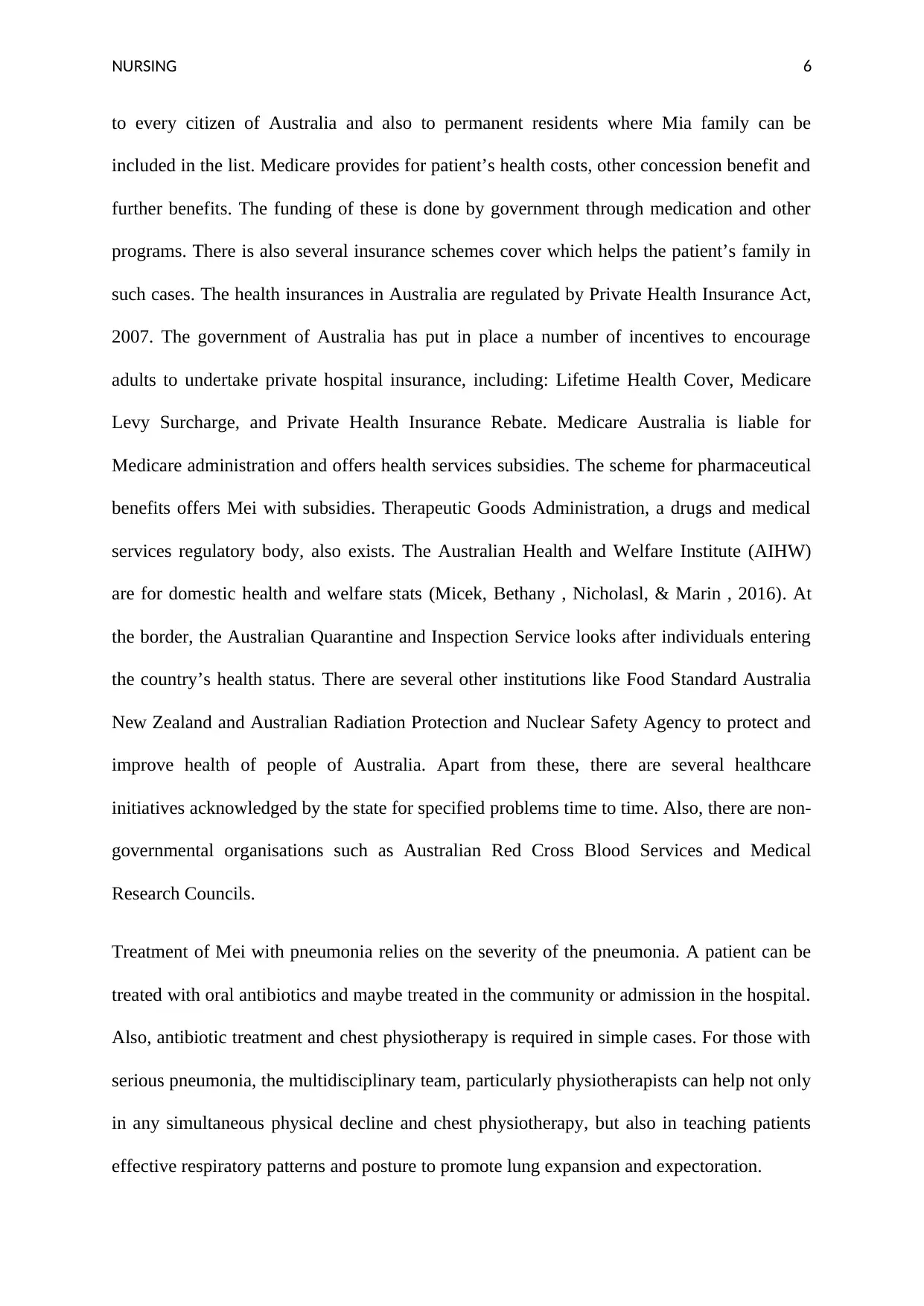
NURSING 6
to every citizen of Australia and also to permanent residents where Mia family can be
included in the list. Medicare provides for patient’s health costs, other concession benefit and
further benefits. The funding of these is done by government through medication and other
programs. There is also several insurance schemes cover which helps the patient’s family in
such cases. The health insurances in Australia are regulated by Private Health Insurance Act,
2007. The government of Australia has put in place a number of incentives to encourage
adults to undertake private hospital insurance, including: Lifetime Health Cover, Medicare
Levy Surcharge, and Private Health Insurance Rebate. Medicare Australia is liable for
Medicare administration and offers health services subsidies. The scheme for pharmaceutical
benefits offers Mei with subsidies. Therapeutic Goods Administration, a drugs and medical
services regulatory body, also exists. The Australian Health and Welfare Institute (AIHW)
are for domestic health and welfare stats (Micek, Bethany , Nicholasl, & Marin , 2016). At
the border, the Australian Quarantine and Inspection Service looks after individuals entering
the country’s health status. There are several other institutions like Food Standard Australia
New Zealand and Australian Radiation Protection and Nuclear Safety Agency to protect and
improve health of people of Australia. Apart from these, there are several healthcare
initiatives acknowledged by the state for specified problems time to time. Also, there are non-
governmental organisations such as Australian Red Cross Blood Services and Medical
Research Councils.
Treatment of Mei with pneumonia relies on the severity of the pneumonia. A patient can be
treated with oral antibiotics and maybe treated in the community or admission in the hospital.
Also, antibiotic treatment and chest physiotherapy is required in simple cases. For those with
serious pneumonia, the multidisciplinary team, particularly physiotherapists can help not only
in any simultaneous physical decline and chest physiotherapy, but also in teaching patients
effective respiratory patterns and posture to promote lung expansion and expectoration.
to every citizen of Australia and also to permanent residents where Mia family can be
included in the list. Medicare provides for patient’s health costs, other concession benefit and
further benefits. The funding of these is done by government through medication and other
programs. There is also several insurance schemes cover which helps the patient’s family in
such cases. The health insurances in Australia are regulated by Private Health Insurance Act,
2007. The government of Australia has put in place a number of incentives to encourage
adults to undertake private hospital insurance, including: Lifetime Health Cover, Medicare
Levy Surcharge, and Private Health Insurance Rebate. Medicare Australia is liable for
Medicare administration and offers health services subsidies. The scheme for pharmaceutical
benefits offers Mei with subsidies. Therapeutic Goods Administration, a drugs and medical
services regulatory body, also exists. The Australian Health and Welfare Institute (AIHW)
are for domestic health and welfare stats (Micek, Bethany , Nicholasl, & Marin , 2016). At
the border, the Australian Quarantine and Inspection Service looks after individuals entering
the country’s health status. There are several other institutions like Food Standard Australia
New Zealand and Australian Radiation Protection and Nuclear Safety Agency to protect and
improve health of people of Australia. Apart from these, there are several healthcare
initiatives acknowledged by the state for specified problems time to time. Also, there are non-
governmental organisations such as Australian Red Cross Blood Services and Medical
Research Councils.
Treatment of Mei with pneumonia relies on the severity of the pneumonia. A patient can be
treated with oral antibiotics and maybe treated in the community or admission in the hospital.
Also, antibiotic treatment and chest physiotherapy is required in simple cases. For those with
serious pneumonia, the multidisciplinary team, particularly physiotherapists can help not only
in any simultaneous physical decline and chest physiotherapy, but also in teaching patients
effective respiratory patterns and posture to promote lung expansion and expectoration.
Paraphrase This Document
Need a fresh take? Get an instant paraphrase of this document with our AI Paraphraser
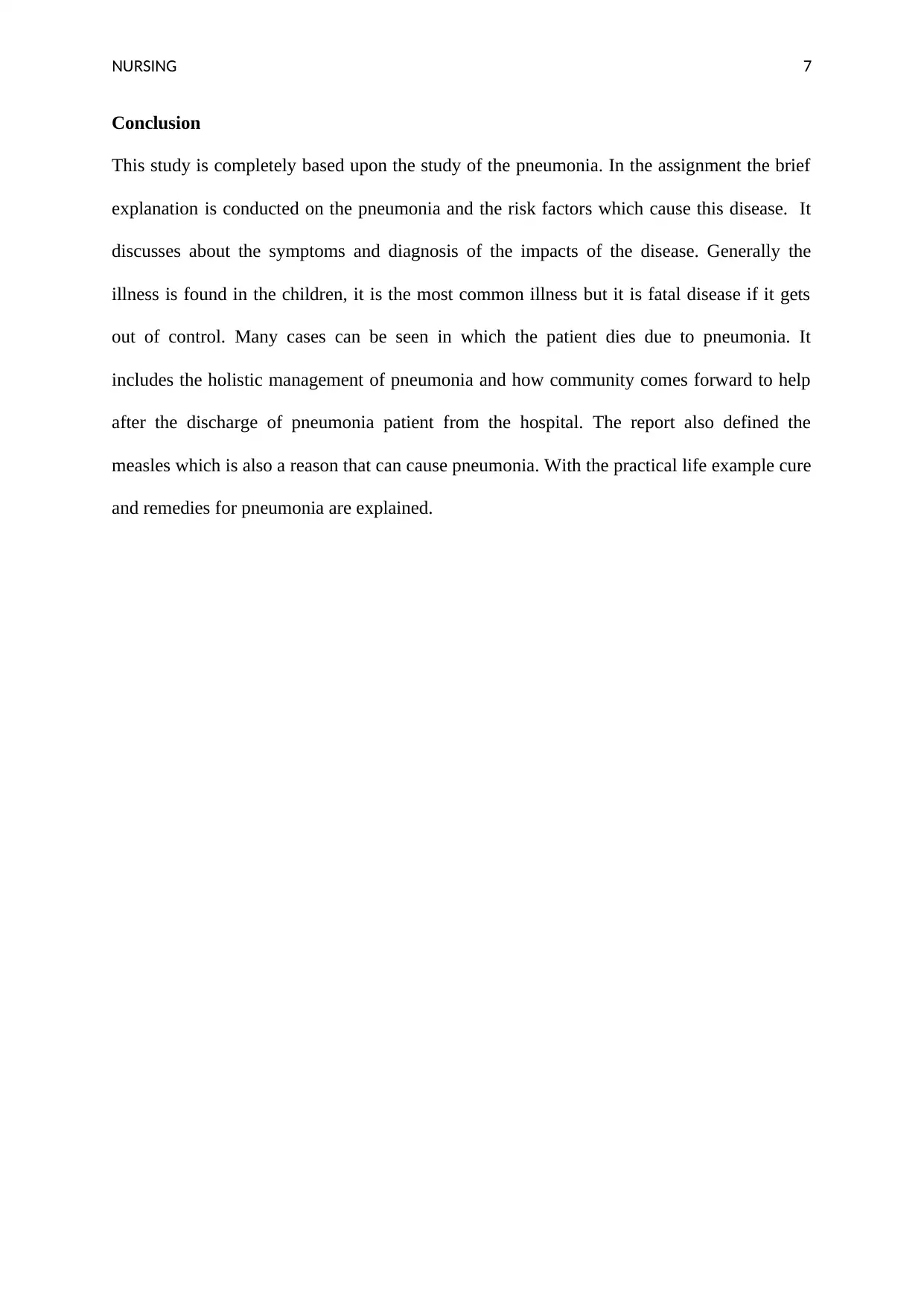
NURSING 7
Conclusion
This study is completely based upon the study of the pneumonia. In the assignment the brief
explanation is conducted on the pneumonia and the risk factors which cause this disease. It
discusses about the symptoms and diagnosis of the impacts of the disease. Generally the
illness is found in the children, it is the most common illness but it is fatal disease if it gets
out of control. Many cases can be seen in which the patient dies due to pneumonia. It
includes the holistic management of pneumonia and how community comes forward to help
after the discharge of pneumonia patient from the hospital. The report also defined the
measles which is also a reason that can cause pneumonia. With the practical life example cure
and remedies for pneumonia are explained.
Conclusion
This study is completely based upon the study of the pneumonia. In the assignment the brief
explanation is conducted on the pneumonia and the risk factors which cause this disease. It
discusses about the symptoms and diagnosis of the impacts of the disease. Generally the
illness is found in the children, it is the most common illness but it is fatal disease if it gets
out of control. Many cases can be seen in which the patient dies due to pneumonia. It
includes the holistic management of pneumonia and how community comes forward to help
after the discharge of pneumonia patient from the hospital. The report also defined the
measles which is also a reason that can cause pneumonia. With the practical life example cure
and remedies for pneumonia are explained.
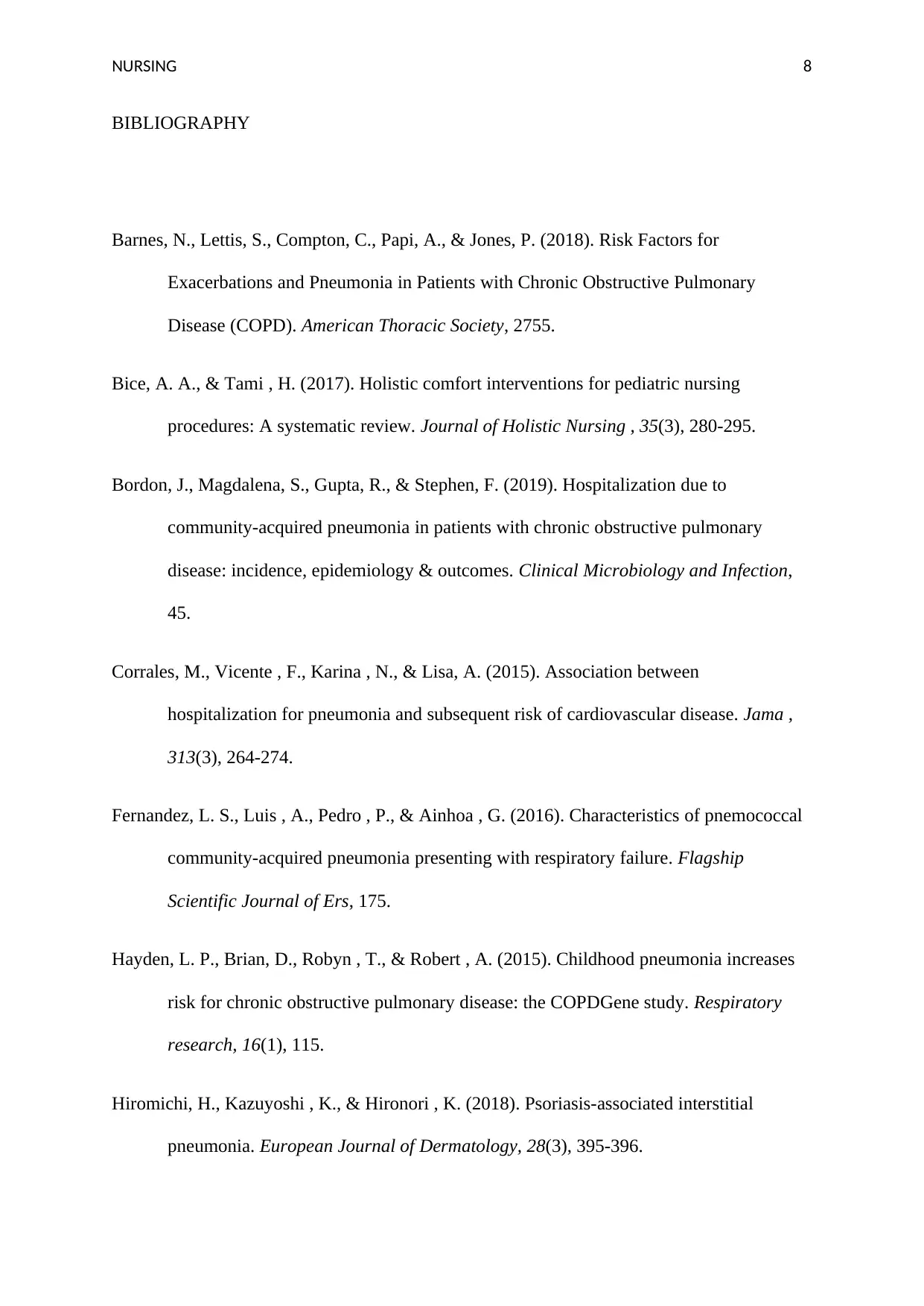
NURSING 8
BIBLIOGRAPHY
Barnes, N., Lettis, S., Compton, C., Papi, A., & Jones, P. (2018). Risk Factors for
Exacerbations and Pneumonia in Patients with Chronic Obstructive Pulmonary
Disease (COPD). American Thoracic Society, 2755.
Bice, A. A., & Tami , H. (2017). Holistic comfort interventions for pediatric nursing
procedures: A systematic review. Journal of Holistic Nursing , 35(3), 280-295.
Bordon, J., Magdalena, S., Gupta, R., & Stephen, F. (2019). Hospitalization due to
community-acquired pneumonia in patients with chronic obstructive pulmonary
disease: incidence, epidemiology & outcomes. Clinical Microbiology and Infection,
45.
Corrales, M., Vicente , F., Karina , N., & Lisa, A. (2015). Association between
hospitalization for pneumonia and subsequent risk of cardiovascular disease. Jama ,
313(3), 264-274.
Fernandez, L. S., Luis , A., Pedro , P., & Ainhoa , G. (2016). Characteristics of pnemococcal
community-acquired pneumonia presenting with respiratory failure. Flagship
Scientific Journal of Ers, 175.
Hayden, L. P., Brian, D., Robyn , T., & Robert , A. (2015). Childhood pneumonia increases
risk for chronic obstructive pulmonary disease: the COPDGene study. Respiratory
research, 16(1), 115.
Hiromichi, H., Kazuyoshi , K., & Hironori , K. (2018). Psoriasis-associated interstitial
pneumonia. European Journal of Dermatology, 28(3), 395-396.
BIBLIOGRAPHY
Barnes, N., Lettis, S., Compton, C., Papi, A., & Jones, P. (2018). Risk Factors for
Exacerbations and Pneumonia in Patients with Chronic Obstructive Pulmonary
Disease (COPD). American Thoracic Society, 2755.
Bice, A. A., & Tami , H. (2017). Holistic comfort interventions for pediatric nursing
procedures: A systematic review. Journal of Holistic Nursing , 35(3), 280-295.
Bordon, J., Magdalena, S., Gupta, R., & Stephen, F. (2019). Hospitalization due to
community-acquired pneumonia in patients with chronic obstructive pulmonary
disease: incidence, epidemiology & outcomes. Clinical Microbiology and Infection,
45.
Corrales, M., Vicente , F., Karina , N., & Lisa, A. (2015). Association between
hospitalization for pneumonia and subsequent risk of cardiovascular disease. Jama ,
313(3), 264-274.
Fernandez, L. S., Luis , A., Pedro , P., & Ainhoa , G. (2016). Characteristics of pnemococcal
community-acquired pneumonia presenting with respiratory failure. Flagship
Scientific Journal of Ers, 175.
Hayden, L. P., Brian, D., Robyn , T., & Robert , A. (2015). Childhood pneumonia increases
risk for chronic obstructive pulmonary disease: the COPDGene study. Respiratory
research, 16(1), 115.
Hiromichi, H., Kazuyoshi , K., & Hironori , K. (2018). Psoriasis-associated interstitial
pneumonia. European Journal of Dermatology, 28(3), 395-396.
⊘ This is a preview!⊘
Do you want full access?
Subscribe today to unlock all pages.

Trusted by 1+ million students worldwide
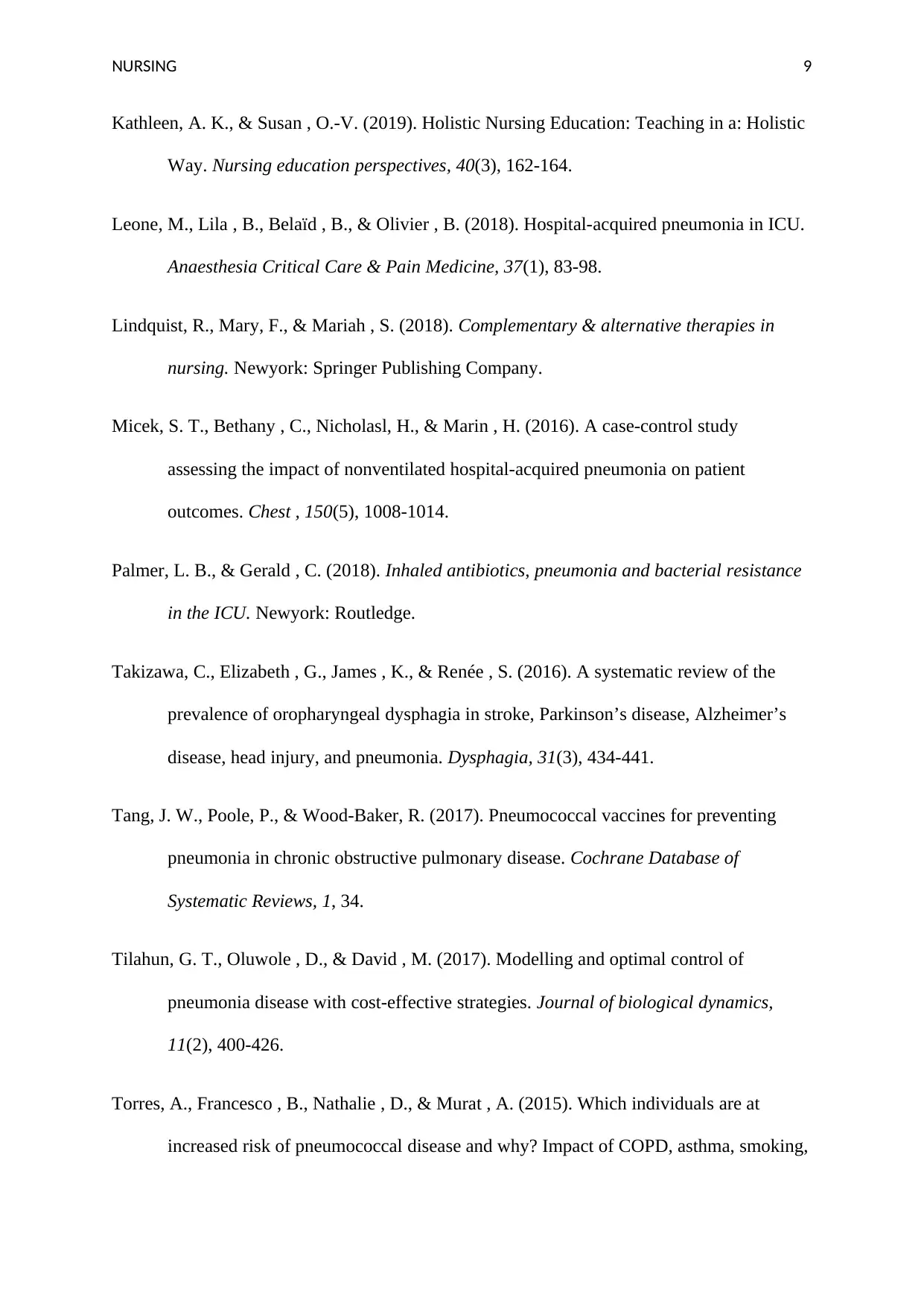
NURSING 9
Kathleen, A. K., & Susan , O.-V. (2019). Holistic Nursing Education: Teaching in a: Holistic
Way. Nursing education perspectives, 40(3), 162-164.
Leone, M., Lila , B., Belaïd , B., & Olivier , B. (2018). Hospital-acquired pneumonia in ICU.
Anaesthesia Critical Care & Pain Medicine, 37(1), 83-98.
Lindquist, R., Mary, F., & Mariah , S. (2018). Complementary & alternative therapies in
nursing. Newyork: Springer Publishing Company.
Micek, S. T., Bethany , C., Nicholasl, H., & Marin , H. (2016). A case-control study
assessing the impact of nonventilated hospital-acquired pneumonia on patient
outcomes. Chest , 150(5), 1008-1014.
Palmer, L. B., & Gerald , C. (2018). Inhaled antibiotics, pneumonia and bacterial resistance
in the ICU. Newyork: Routledge.
Takizawa, C., Elizabeth , G., James , K., & Renée , S. (2016). A systematic review of the
prevalence of oropharyngeal dysphagia in stroke, Parkinson’s disease, Alzheimer’s
disease, head injury, and pneumonia. Dysphagia, 31(3), 434-441.
Tang, J. W., Poole, P., & Wood‐Baker, R. (2017). Pneumococcal vaccines for preventing
pneumonia in chronic obstructive pulmonary disease. Cochrane Database of
Systematic Reviews, 1, 34.
Tilahun, G. T., Oluwole , D., & David , M. (2017). Modelling and optimal control of
pneumonia disease with cost-effective strategies. Journal of biological dynamics,
11(2), 400-426.
Torres, A., Francesco , B., Nathalie , D., & Murat , A. (2015). Which individuals are at
increased risk of pneumococcal disease and why? Impact of COPD, asthma, smoking,
Kathleen, A. K., & Susan , O.-V. (2019). Holistic Nursing Education: Teaching in a: Holistic
Way. Nursing education perspectives, 40(3), 162-164.
Leone, M., Lila , B., Belaïd , B., & Olivier , B. (2018). Hospital-acquired pneumonia in ICU.
Anaesthesia Critical Care & Pain Medicine, 37(1), 83-98.
Lindquist, R., Mary, F., & Mariah , S. (2018). Complementary & alternative therapies in
nursing. Newyork: Springer Publishing Company.
Micek, S. T., Bethany , C., Nicholasl, H., & Marin , H. (2016). A case-control study
assessing the impact of nonventilated hospital-acquired pneumonia on patient
outcomes. Chest , 150(5), 1008-1014.
Palmer, L. B., & Gerald , C. (2018). Inhaled antibiotics, pneumonia and bacterial resistance
in the ICU. Newyork: Routledge.
Takizawa, C., Elizabeth , G., James , K., & Renée , S. (2016). A systematic review of the
prevalence of oropharyngeal dysphagia in stroke, Parkinson’s disease, Alzheimer’s
disease, head injury, and pneumonia. Dysphagia, 31(3), 434-441.
Tang, J. W., Poole, P., & Wood‐Baker, R. (2017). Pneumococcal vaccines for preventing
pneumonia in chronic obstructive pulmonary disease. Cochrane Database of
Systematic Reviews, 1, 34.
Tilahun, G. T., Oluwole , D., & David , M. (2017). Modelling and optimal control of
pneumonia disease with cost-effective strategies. Journal of biological dynamics,
11(2), 400-426.
Torres, A., Francesco , B., Nathalie , D., & Murat , A. (2015). Which individuals are at
increased risk of pneumococcal disease and why? Impact of COPD, asthma, smoking,
Paraphrase This Document
Need a fresh take? Get an instant paraphrase of this document with our AI Paraphraser
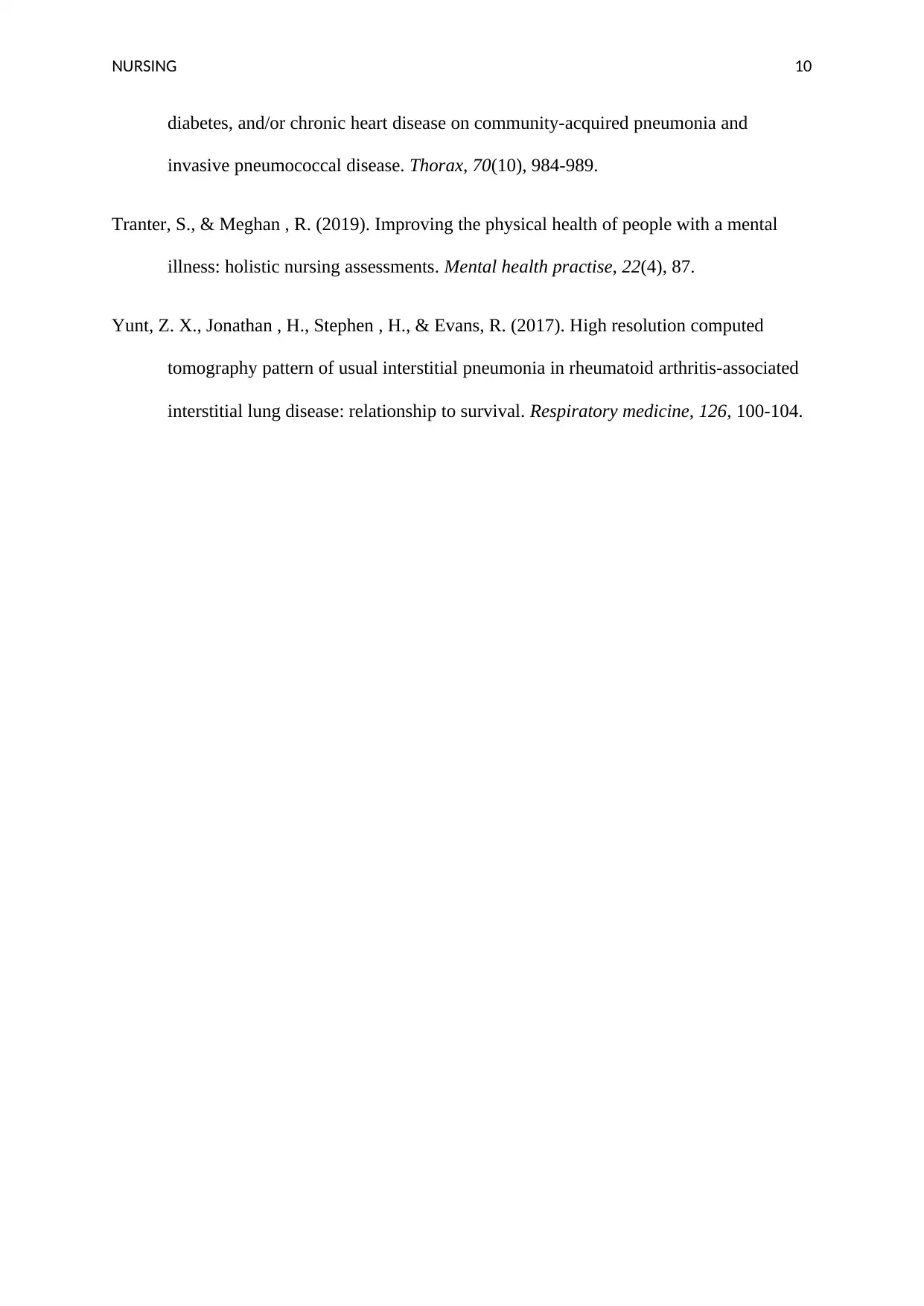
NURSING 10
diabetes, and/or chronic heart disease on community-acquired pneumonia and
invasive pneumococcal disease. Thorax, 70(10), 984-989.
Tranter, S., & Meghan , R. (2019). Improving the physical health of people with a mental
illness: holistic nursing assessments. Mental health practise, 22(4), 87.
Yunt, Z. X., Jonathan , H., Stephen , H., & Evans, R. (2017). High resolution computed
tomography pattern of usual interstitial pneumonia in rheumatoid arthritis-associated
interstitial lung disease: relationship to survival. Respiratory medicine, 126, 100-104.
diabetes, and/or chronic heart disease on community-acquired pneumonia and
invasive pneumococcal disease. Thorax, 70(10), 984-989.
Tranter, S., & Meghan , R. (2019). Improving the physical health of people with a mental
illness: holistic nursing assessments. Mental health practise, 22(4), 87.
Yunt, Z. X., Jonathan , H., Stephen , H., & Evans, R. (2017). High resolution computed
tomography pattern of usual interstitial pneumonia in rheumatoid arthritis-associated
interstitial lung disease: relationship to survival. Respiratory medicine, 126, 100-104.
1 out of 11
Related Documents
Your All-in-One AI-Powered Toolkit for Academic Success.
+13062052269
info@desklib.com
Available 24*7 on WhatsApp / Email
![[object Object]](/_next/static/media/star-bottom.7253800d.svg)
Unlock your academic potential
© 2024 | Zucol Services PVT LTD | All rights reserved.




